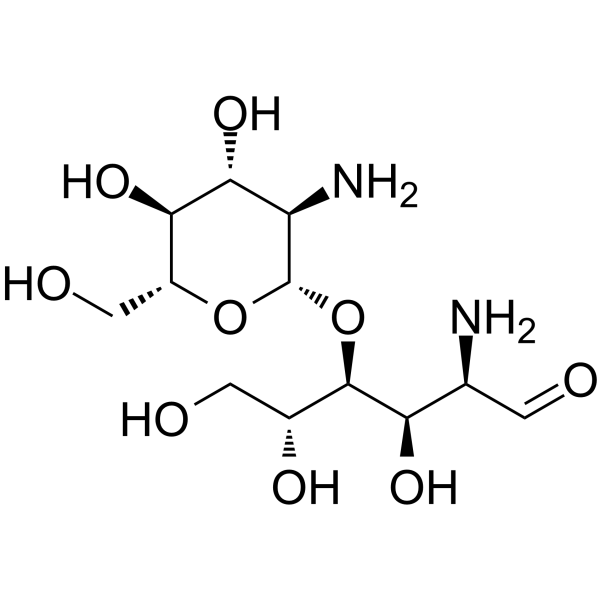CHITOBIOSE DIHYDROCHLORIDE
Modify Date: 2025-08-25 10:53:10

CHITOBIOSE DIHYDROCHLORIDE structure
|
Common Name | CHITOBIOSE DIHYDROCHLORIDE | ||
|---|---|---|---|---|
| CAS Number | 577-76-4 | Molecular Weight | 413.24900 | |
| Density | 1.58g/cm3 | Boiling Point | 736.2ºC at 760mmHg | |
| Molecular Formula | C12H26Cl2N2O9 | Melting Point | N/A | |
| MSDS | USA | Flash Point | 399ºC | |
Use of CHITOBIOSE DIHYDROCHLORIDEChitobiose, a chitosan oligosaccharide, is a dimer of β-1,4-linked glucosamine units[1]. Chitobiose has orally activity and high antioxidant activity[2]. |
| Name | chitobiose dihydrochloride |
|---|---|
| Synonym | More Synonyms |
| Description | Chitobiose, a chitosan oligosaccharide, is a dimer of β-1,4-linked glucosamine units[1]. Chitobiose has orally activity and high antioxidant activity[2]. |
|---|---|
| Related Catalog | |
| In Vivo | Chitobiose (30, 100, 300 mg/kg; p.o., single) can enters the circulatory system when given orally[2]. Pharmacokinetic Parameters of Chitobiose in Wistar strain male rats[2]. PO (30 mg/kg) PO (100 mg/kg) PO (300 mg/kg) Tmax (h) 0.9 1.0 1.8 Cpmax (μg/mL) 1.1 4.4 6.9 AUC0-4h (μg·h/mL) 2.5 9.0 17.6 AUMC0-4h (μg·h^2/mL) 4.0 13.2 35.6 MRT (h) 1.6 1.5 1.6 MAT (h) 1.1 1.0 1.2 ka (h^-1) 0.95 0.99 0.96 F1-4h (%) 1.8 2.0 1.3 Animal Model: Wistar strain male rats (7 weeks, 165-185 g)[2] Dosage: 30, 100, 300 mg/kg Administration: p.o., single (Pharmacokinetics analysis) Result: Entered the circulatory system when given orally. |
| References |
| Density | 1.58g/cm3 |
|---|---|
| Boiling Point | 736.2ºC at 760mmHg |
| Molecular Formula | C12H26Cl2N2O9 |
| Molecular Weight | 413.24900 |
| Flash Point | 399ºC |
| Exact Mass | 412.10200 |
| PSA | 201.11000 |
| Index of Refraction | 1.604 |
| Storage condition | 2-8C |
| Chitobiose 2HCl |